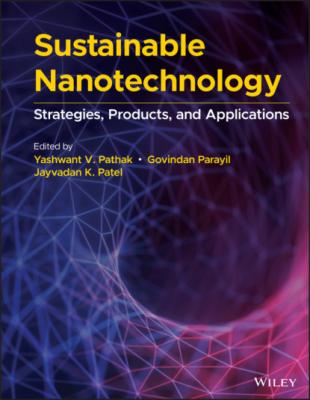Sustainable Nanotechnology. Группа авторов
Читать онлайн.| Название | Sustainable Nanotechnology |
|---|---|
| Автор произведения | Группа авторов |
| Жанр | |
| Серия | |
| Издательство | |
| Год выпуска | 0 |
| isbn | 9781119650317 |
3.10 Green Nanotechnology (GNT) in Secondary Industry Sector
The secondary industry sector in an economy includes secondary processing of raw materials as inputs into various usable products using different types of machines. The output of the secondary industries is manufactured or assembled finished products which are tangible in nature. GNT principles and processes have direct implications of business performance in the secondary industry sector. Table 3.6 lists opportunities and challenges for GNT‐based innovations in some of the secondary industry sectors.
3.11 Green Nanotechnology in Tertiary Industry Sector
The tertiary industry sector in an economy includes business which offers various services to consumers. These services are usually intangible in nature and produce high gross domestic products (GDP) and employment. GNT affects the service industry sector both directly and indirectly. GNT principles and processes have implications in future performances in this industry sector. Table 3.7 lists opportunities and challenges for GNT‐based innovations in the tertiary industry sector.
Table 3.5 Green nanotechnology‐based innovations in primary industry sector.
| S. No. | Natural resources industries | Opportunities (O) and challenges (C) of green nanotechnology |
|---|---|---|
| 1 | Agriculture | O: Use of nanofertilizers, nanopesticides, nanobiosensors, and nano‐enabled remediation are used in precision forming and biotic and abiotic remediation, for controlled release of nutrients to targeted soils, soil biota, soil organic matter, and plant morphological and physiological responses, aimed to obtain their fullest biological efficacy without overdosage |
| Nano‐sensors and nano‐remediation methods may detect and remove environmental contaminants | ||
| C: There is limited knowledge concerning nanomaterial biosafety, adverse effects, fate, and acquired biological reactivity once dispersed into the environment, which requires further scientific efforts to assess possible nano‐agricultural risks | ||
| Lack of adequate risk management strategies for workers, occupational safety practices, and policies, as well as to develop a responsible regulatory consensus | ||
| 2 | Forestry | O: Green nanotechnology has the ability to reduce carbon footprints of petroleum‐based products by means of renewable forest‐based nanocellulose. Nanocellulose is considered important material for research and development of plastics, coatings, sensors, electronics, automobile body and aerospace materials, medical implants, and body armor so that future day plastics, cellular telephones, medical implants, body armor, and flexible displays will be produced as forest products |
| C: To achieve improvement in the performance‐to‐weight ratio of paper and packaging products through green nanotechnology to create features such as optical, electronic, barrier, sensing thermal, and surface texture | ||
| 3 | Mining | O: Use of nanosized vessels to recover valuable minerals that end up in the waste |
| Use of green nanomaterials like graphene coatings on drill bits that perform borehole drilling to increase effectiveness and longevity | ||
| Use of green nanomaterial for lubrication for all the mechanical parts heavy‐duty machinery to work optimally | ||
| Use of green nanotechnology allows us to isolate gold from raw materials in a selective manner instead of using cyanide | ||
| C: To prove that the nanoparticles prepared through the green route used in mining do not have side effects for mining workers and the environment | ||
| 4 | Fisheries | O: Green nanotechnology can revolutionize fisheries and aquaculture industry with new tools like rapid disease detection, to speed up the absorption of drugs like hormones, vaccines, and nutrients to fish, and by using antibacterial nanocoatings, shelf life of fish, and shellfish may be improved. Green supply chain using nanotechnology can decrease supply chain time between origin to destination |
| Nanotechnological applications in fisheries also include antibacterial surfaces in the aquaculture system, nano delivery of veterinary products in fish food using porous nanostructures, and nanosensors for detecting pathogens in the water including removing microbes, organic chemicals, and metals | ||
| C: Proper methods of measurement of environmental effects and the surveillance of nanomaterials in products, especially food such as fish fillets, are needed | ||
| 5 | Oil and natural gas | O: Green nanotechnology provides nanomaterials to be used as drilling fluids and enhanced oil recovery in addition to other applications including cementing and well stimulation to enhance well productivity |
| C: Economic feasibility of nanoparticle to be used and their commercial availability. To know the hazardous nature of nanoparticles on health, environment, and safety, and predicted severe health issues |
Table 3.6 Nanotechnology‐based manufacturing innovations in secondary industry sector.
| S. No. | Manufacturing industries | Opportunities (O) and challenges (C) of green nanotechnology |
|---|---|---|
| 1 | Potable water sector | O: Green nanotechnology can be used to convert impure water and seawater into potable water. The nanofilters made by nanomembranes can remove all kinds of water contaminants including turbidity, oil, bacteria, viruses, and organic contaminants from impure water or salt from seawater |
| C: Implementation of nanotechnology‐enabled alternatives systematically using optimum nanomembranes for the conversion of impure water into potable water throughout the world in a fixed timeframe | ||
| 2 | Environment cleaning sector | O: Green nanotechnology products, processes, and applications are capable to clean degraded environments including air cleaning, water cleaning, and sound cleaning and controls climate change by reducing greenhouse gases and hazardous wastes |
| C: Implementation of systematically designed low‐cost renewable energy supported nanotechnology‐based environment purifying system in every country within a fixed timeline | ||
| 3 | Food and food processing sector | O: Use of green nanotechnology in food protection and delivery to targeted sites, improving food flavor, to encapsulate nutrients such as vitamins, adding antibacterial green nanoparticles into food for enhancement of shelf life, sensing the contamination, improving food storage, tracking, training, brand protection, etc. |
